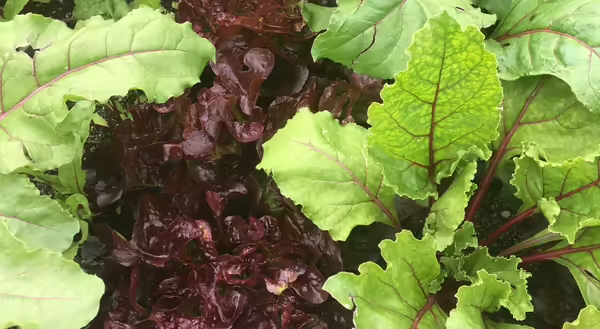
Every gardener should be thinking about growing their own greens in the spring. They are easy to grow, have large harvests, and taste best when grown in slightly cooler weather. The plants should be grown in full sun beds or containers.
Kale is a cool-weather crop that is beloved for its large textured leaves. Transplants can be planted in the garden three to four weeks before the last frost date in the spring (April 10 in central Illinois). Kale grows three to four feet tall. Space plants 18-24 inches apart; add compost before planting and a layer of mulch after planting to conserve moisture. The outer leaves are harvested while they are tender and young, leaving the plant looking like a palm tree. A popular cultivar is 'Lacinato Rainbow,' with vigorous, curly, dark leaves with pink veins and great cold hardiness.
Swiss chard is actually a beet plant that has been selected for its bright and colorful leaves rather than its root mass. "Bright Lights" is the standard-bearer for multicolored Swiss chard. It’s even sold as an ornamental at many garden centers. Otherwise, plant as soon as the soil is workable and above 40° F. Harvest similar to kale. If grown for baby leaves, start from seed and harvest the entire plant at three inches tall. If a continued harvest is desired, start from a transplant and remove outer leaves as the plant continues to grow.
Beet seeds can also be planted as soon as the soil is workable and above 40° F. No more than a third of the beet greens should be harvested from the plant while it is producing the deep red orb. Seeds should be thinned to three or four inches; the small seedlings make a delicious harvest.
Spinach is best grown in the cool weather because once warm temperatures arrive it will bolt and flower, bringing out a bitter taste. It is best to grow a plain-leaf versus crinkly leaf because the crinkles catch soil particles. As soon as the soil is workable, broadcast seeds. When plants are one inch tall, space seedlings to three inches (again, a great early salad of spinach seedlings). Entire plants can be harvested or the outer leaves can be removed for continued harvest.
Other cool season greens to include in the salad mix are red lettuce, green lettuce, watercress, arugula, minutina, claytonia and endive. Harvest leaves at 3 inches.
Don’t miss out on one of the best growing seasons while you are waiting for the weather to warm. Once weather warms and you have harvested your cool season greens, plant warm season crops like tomatoes, peppers and eggplant.
For more information, join Facebook Live with the Horticulturists on April 8 at noon, which will cover everything you need to know about cool-season vegetables with our special guest, Nick Frillman. To join the live show at http://www.facebook.com/UIextension.